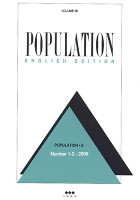
Population 2005 n° 1/2
2005
- Restoring the Notion of Family in France : Pronatalist and Pro-family Propaganda in Schools and Army Barracks (1920-1940) - De Luca Virginie
- Partner Supply in Britain and the US : Estimates and Gender Contrasts - Ní Bhrolcháin Máire, Sigle-Rushton Wendy
- Disability in French prisons : how does the situation differ from that of the general population? - Désesquelle Aline
- Working Conditions : How are Older Workers Protected in France? - Pailhé Ariane
- Cause-specific Mortality in France and in the Former FRG, 1950-95 : Similarities and Differences - Haudidier Benoît
Short Paper
- Women’s employment and fertility in Latin America : a review of the question - I. SCHOCKAERT
De Luca Virginie
This article examines the activities of militants advocating the introduction of pronatalist and pro-family education in French schools and army barracks between 1920 and 1940. After the First World War, the main pronatalist association, the Alliance nationale pour l’accroissement de la population française (National Alliance for the Growth of the French Population), undertook to raise awareness among children and young adults about the decline in the birth rate. We examine under what conditions this teaching was initiated, the means used to disseminate the information produced and the consequences of its introduction. We show that this teaching made it possible to introduce population issues and the techniques and tools of demographic analysis into schools. The pronatalist activists thus contributed to the establishment of "literacy in demography", though their objective was to educate individuals rather than to initiate them to demography and population issues.
Partner Supply in Britain and the US : Estimates and Gender Contrasts
Ní Bhrolcháin Máire, Sigle-Rushton Wendy
Marriage market estimates by sex and age are made for the US and England and Wales in 1990-91, using explicit data on age preferences. Availability is strongly differentiated by age and sex; it decreases with age for women, while the opposite is true for men. Decomposition shows that young women are advantaged largely by age preferences while older men are advantaged by population age-sex and marital status structure. Most men marry at ages when partners are in short supply, a finding that is examined in detail. Implications for gender power relations through the life course are considered.
Disability in French prisons : how does the situation differ from that of the general population?
Désesquelle Aline
In 2001, an extension of the " HID" disability and dependency survey was conducted on a sample of almost 1,300 prisoners in France. One prisoner in two has at least one disability. The frequency of mental disability is particularly high. For a similar age and sex structure, the prevalence of physical disabilities is almost three times higher among prisoners than among the general population. This difference is the result of two effects that are difficult to dissociate: a selection effect at entry into prison and a detention effect. For example, among prisoners serving long sentences, after controlling for age, the time already spent in prison is significantly correlated with the presence of disabilities. Prisoners with disabilities are likely to need assistance, be it human help, technical aids or cell adaptations. 8% of prisoners have such needs. Need of assistance is particularly frequent among prisoners with motor impairments, but also among prisoners who are often older, who all suffer from a sensory impairment and who also often have several types of impairment.
Working Conditions: How are Older Workers Protected in France?
Pailhé Ariane
Since the 1980s, working conditions in France have been deteriorating, notably as a result of organizational changes in the industrial and business environment. Older employees make up a group that is particularly vulnerable to this sort of transformation. We will therefore examine to what extent protection designed for these workers in the 1970s still remains in place. Are older workers less exposed to occupational strain? If so, does this result from protection or selection? Cross-sectional surveys of working conditions conducted by DARES and INSEE in 1984, 1991 and 1998 have been used to answer these questions. Data analysis brings to light three groups of work constraints: physical strain, working time flexibility and commercial demands. All things being equal elsewhere, we will see that age protects workers against physical strain, particularly women. Men, for their part, become less exposed to commercial demands as they grow older. But although protection mechanisms designed for older people continue to exist, the relative protection they afford has decreased over time. Furthermore, beyond the age of 55, protection against physical strain often takes the form of exclusion from the labour market.
Cause-specific Mortality in France and in the Former FRG, 1950-95 : Similarities and Differences
Haudidier Benoît
Despite a general convergence of mortality patterns in western Europe, major differences still exist between certain countries. Thus, the comparison between the former FRG and France shows that the structure of age-specific mortality has undergone a markedly different evolution. The phenomenon is due to strongly diverging trends in the main causes of death. Thus, cardiovascular mortality has evolved much more favourably in France than in the former FRG over the period, whereas the former FRG has held an advantage since 1970 for mortality from violent causes and infectious diseases. Major sex differentials in mortality between the two countries are also observed for degenerative pathologies (cardiovascular disease and cancers) and cirrhoses. These differences of level and trends reflect the greater similarity of male and female lifestyles - notably with respect to alcohol consumption and smoking - in northern than in southern Europe. More generally, they illustrate the cultural resistance of the German and French populations to the growing uniformity of living conditions.
Prix TTC : 20,00 €

